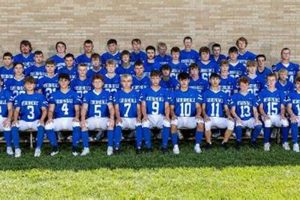Athletic cups are protective gear designed to safeguard the male genitalia from impact during sports activities. They are typically made of a hard plastic shell lined with softer padding and held in place by a supportive jockstrap. While their use might seem self-explanatory, understanding their role in injury prevention provides valuable context.
Protecting athletes from potential testicular injuries is paramount. Such injuries, though relatively uncommon, can be extremely painful and, in rare cases, have long-term consequences. The use of protective equipment like athletic cups has become a standard practice in many contact sports to mitigate these risks. Historically, concern for player safety has driven the adoption of various protective measures in football, and the use of cups has become integrated into this broader movement.
The prevalence of cup usage in high school football, the specific types of cups available, and the perspectives of coaches, players, and medical professionals regarding their use are explored further in the sections below.
Tips for Athletic Cup Use in High School Football
The following tips provide guidance on selecting and utilizing athletic cups for optimal protection and comfort in high school football.
Tip 1: Select the Right Size: Proper fit is crucial for effectiveness and comfort. Cups that are too small can be restrictive and offer inadequate protection, while cups that are too large can shift and be uncomfortable. Consulting sizing charts provided by manufacturers is recommended.
Tip 2: Choose the Right Style: Different cup designs cater to various preferences and playing positions. Traditional hard-shell cups offer robust protection, while compression shorts with built-in cups offer a more streamlined fit. Consider individual needs and comfort levels when making a selection.
Tip 3: Ensure Proper Positioning: The cup should be positioned to fully cover the area it is designed to protect. The supporting jockstrap should fit snugly but not restrictively, keeping the cup securely in place during movement.
Tip 4: Regularly Inspect and Replace: Cups can become damaged or worn over time, reducing their effectiveness. Inspect the cup for cracks or damage before each use and replace it as needed.
Tip 5: Integrate into Routine: Consistent use of an athletic cup during practices and games is essential for maximizing protection. Making it a regular part of the pre-game routine helps ensure it isn’t forgotten.
Tip 6: Address Concerns and Discomfort: Players should feel comfortable discussing any discomfort or concerns regarding cup use with their coaches or athletic trainers. Finding the right fit and style is crucial for optimal protection and performance.
Prioritizing player safety is paramount in high school football. By following these tips, athletes can ensure they are utilizing athletic cups effectively to minimize the risk of injury.
The consistent and correct use of athletic cups contributes significantly to player safety, allowing athletes to focus on the game without unnecessary worry.
1. Protection
The primary purpose of athletic cups in high school football is protection against impact injuries to the male genitalia. The physical nature of the sport, involving frequent collisions and potential contact with other players, equipment, and the ground, presents a risk of such injuries. While not all impacts are severe, the sensitive nature of the area makes even minor blows potentially painful and debilitating. Cups provide a crucial layer of defense, significantly reducing the force of impact and minimizing the risk of serious injury. This protective function is central to understanding their importance in the context of high school football.
Consider, for instance, a low tackle or a fall onto the ball. Without a cup, these common occurrences could result in significant pain and potential long-term complications. The protective barrier offered by the cup can prevent or mitigate such injuries, allowing athletes to continue playing with reduced risk. This protection allows athletes to focus on the game without fear of debilitating injury, enhancing both performance and overall well-being. The consequences of not wearing a cup can range from temporary discomfort to severe trauma, emphasizing the practical significance of prioritizing protection.
In summary, the connection between athletic cups and protection in high school football is fundamental. The physical demands and inherent risks of the sport necessitate protective measures, and the cup plays a vital role in safeguarding players from potentially serious injuries. Understanding the importance of this protective function is essential for players, coaches, and anyone involved in ensuring the safety and well-being of high school football athletes. This focus on protection underscores a commitment to player health and responsible athletic participation.
2. Regulations
Regulations regarding athletic cups in high school football vary. While national governing bodies like the National Federation of State High School Associations (NFHS) provide guidelines for player safety and equipment, they do not mandate cup use. This often leaves the decision to state or even individual league regulations. Some states or leagues may require cups, while others may only recommend them. This decentralized regulatory landscape can lead to inconsistencies in practice, with some players required to wear cups while others are not, even within the same state. This variability underscores the importance of consulting specific league rules to ensure compliance. For example, a player transferring from a league with mandatory cup use to one without may be unaware of the change and unknowingly expose himself to increased risk.
The absence of a universal mandate for cup use despite the potential for injury raises practical questions. Should a national standard be implemented? What are the arguments for and against mandatory cup use at all levels of high school football? The potential benefits of increased player safety must be weighed against arguments regarding personal choice and comfort. Some argue that mandating protective gear infringes on personal autonomy, while others contend that the potential for serious injury necessitates a uniform standard. This ongoing debate highlights the complex interplay between safety regulations, individual freedom, and the overall well-being of student-athletes. The lack of clear, consistent regulation emphasizes the need for continued discussion and evaluation of best practices for player safety in high school football.
In summary, the regulatory landscape surrounding athletic cup use in high school football presents a fragmented picture. While some leagues mandate their use, many do not, creating a complex and potentially confusing situation for players, coaches, and parents. The lack of a uniform standard necessitates a deeper understanding of the relevant rules at each level of competition. This understanding is crucial not only for compliance but also for informed decision-making regarding player safety. The ongoing discussion surrounding mandatory cup use emphasizes the need for continued evaluation and potential standardization of regulations to ensure optimal protection for all high school football players.
3. Comfort
Comfort plays a significant role in the decision of whether or not to wear an athletic cup in high school football. While protection is the primary function, an ill-fitting or uncomfortable cup can be a distraction, potentially hindering performance. A cup that is too tight can restrict movement, while one that is too loose can shift out of place, negating its protective benefits. This balance between protection and comfort is crucial. Finding the right size and style is essential. Some players opt for compression shorts with built-in cups for a more streamlined and less restrictive feel, while others prefer traditional hard-shell cups for maximum protection, even if it means slightly less comfort. For example, a running back who requires agility and freedom of movement might prioritize a snug-fitting, less bulky option, whereas a lineman engaged in frequent contact might prioritize the enhanced protection of a more substantial cup, even if it means a slight compromise in comfort. Ultimately, the decision often comes down to individual preference and the specific demands of the player’s position.
The material composition of the cup and its supporting jockstrap also contributes to overall comfort. Moisture-wicking fabrics can help keep the area dry and reduce chafing, particularly during hot and humid conditions. Breathable materials can further enhance comfort and minimize skin irritation. A poorly ventilated cup can lead to discomfort and even skin issues, potentially discouraging consistent use. Proper hygiene practices, such as regularly washing the jockstrap and cup, are also essential for maintaining comfort and preventing infections. Neglecting hygiene can lead to skin irritations or infections, further compounding discomfort and potentially leading to avoidance of the protective gear altogether. This underscores the importance of considering not just the physical fit but also the material properties and hygiene practices that contribute to the overall comfort and, therefore, the consistent use of athletic cups.
In conclusion, comfort is a critical factor influencing athletic cup use in high school football. Finding the right balance between protection and comfort is essential for ensuring consistent use and maximizing the protective benefits. Addressing comfort issues through proper sizing, material selection, and hygiene practices can encourage players to prioritize their safety and well-being without compromising performance. Open communication between players, coaches, and athletic trainers regarding any discomfort is crucial for finding suitable solutions and promoting a culture of safety and well-being in high school football. This holistic approach, considering both the physical and psychological aspects of comfort, contributes significantly to the effective integration of protective gear into the sport.
4. Personal Choice
The decision of whether or not to wear an athletic cup in high school football ultimately rests with the individual player. While coaches, trainers, and even parents can offer guidance and strongly encourage its use, personal choice plays a significant role. This autonomy can be influenced by a variety of factors, including perceived comfort levels, social norms within the team, and individual risk assessment. Some players may feel the cup restricts movement or causes discomfort, leading them to forgo its use despite the potential risks. Others might be influenced by teammates who do not wear cups, perceiving it as a sign of toughness or bravado. Conversely, players with a heightened awareness of potential injuries or prior negative experiences may choose to wear a cup consistently, prioritizing safety over other considerations. For instance, a player who has previously experienced a groin injury, even a minor one, might be more inclined to wear a cup consistently, understanding the potential for re-injury. This personal experience can significantly outweigh external influences.
Respecting player autonomy in this decision is crucial, but it also necessitates open and honest conversations about the risks and benefits. Coaches and trainers bear a responsibility to educate players on the potential consequences of foregoing protective gear, emphasizing the importance of safety without coercion. Presenting factual information about injury statistics and the potential severity of groin injuries can empower players to make informed decisions. Creating a team culture that prioritizes safety and encourages open communication about protective equipment can also influence individual choices. For example, a team where coaches openly discuss the importance of cups and veteran players lead by example can create a positive environment that encourages younger players to adopt similar safety practices. Conversely, a team culture where wearing a cup is ridiculed or viewed as a sign of weakness can discourage its use, potentially increasing the risk of injuries.
In summary, personal choice is a significant factor in athletic cup use among high school football players. Balancing individual autonomy with the responsibility to promote player safety requires a nuanced approach. Educating players about the risks and benefits, fostering open communication, and creating a positive team culture that prioritizes safety are essential for empowering informed decision-making and minimizing the potential for preventable injuries. Respecting individual choices while simultaneously emphasizing the importance of protection remains a critical challenge in ensuring the well-being of high school football athletes. Navigating this challenge effectively requires ongoing dialogue and a commitment to fostering a safe and supportive environment for all players.
5. Injury Prevention
Injury prevention is paramount in high school football, and the use of athletic cups plays a crucial role in mitigating the risk of specific, potentially serious injuries. The sensitive nature of the male genitalia makes them particularly vulnerable to impact, and the fast-paced, contact-heavy nature of football creates opportunities for such injuries. While padding and other protective gear offer some level of protection, athletic cups provide a focused layer of defense against direct blows to the groin area. These injuries can range from minor contusions causing temporary pain and discomfort to more severe testicular trauma requiring medical intervention and potentially leading to long-term complications. A well-fitted athletic cup significantly reduces the force of impact, thus minimizing the likelihood and severity of these injuries. For example, a direct hit to the groin during a tackle or a fall onto the ball can cause debilitating pain and potential long-term damage if a cup is not worn. Conversely, wearing a cup can effectively deflect the impact, preventing or mitigating such injuries. This proactive approach to injury prevention is essential for maintaining player health and ensuring their ability to participate fully in the sport.
The practical significance of this understanding extends beyond immediate pain avoidance. Testicular injuries, though relatively uncommon in football, can have lasting consequences, including reduced fertility and chronic pain. Preventing these injuries not only protects players’ physical well-being but also safeguards their future health. Furthermore, minimizing the risk of groin injuries reduces lost playing time due to recovery, allowing athletes to remain active and engaged in the sport. This, in turn, contributes to team cohesion and overall performance. Investing in and consistently using appropriate protective gear, including athletic cups, is a small price to pay for the significant long-term health benefits and sustained participation in the sport. This proactive approach to injury prevention demonstrates a commitment to player well-being and responsible athletic practices.
In summary, the connection between athletic cup use and injury prevention in high school football is clear and demonstrably significant. The potential for serious, long-term consequences from groin injuries underscores the importance of utilizing this readily available protective measure. Promoting the consistent use of athletic cups, educating players on their benefits, and creating a supportive environment that prioritizes injury prevention are crucial for ensuring the health and well-being of high school football athletes. This focus on proactive injury prevention contributes not only to individual player health but also to the overall success and sustainability of the sport.
Frequently Asked Questions
This section addresses common questions and concerns regarding the use of athletic cups in high school football. Clear, factual information is provided to promote understanding and informed decision-making.
Question 1: Are athletic cups required in high school football?
Regulations vary by state and league. While not universally mandated, many leagues strongly recommend or require their use. Consulting specific league rules is essential.
Question 2: What are the primary benefits of wearing an athletic cup?
The primary benefit is protection against impact injuries to the male genitalia, which can range from minor contusions to more serious testicular trauma.
Question 3: How does one choose the right athletic cup?
Proper fit is crucial. Consult manufacturer sizing charts and consider different styles, such as traditional hard-shell cups or compression shorts with built-in cups, to find the best option for individual needs and comfort levels.
Question 4: What should one do if an athletic cup is uncomfortable?
Discomfort often stems from improper fit. Experiment with different sizes and styles to find a better option. Consult with a coach or athletic trainer for personalized guidance. Addressing discomfort is essential for ensuring consistent use and maximizing protective benefits.
Question 5: How often should an athletic cup be replaced?
Regular inspection is crucial. Replace the cup immediately if any cracks or damage are observed. Even without visible damage, periodic replacement is recommended due to general wear and tear.
Question 6: Are there any long-term health risks associated with not wearing an athletic cup?
While rare, untreated testicular injuries can potentially lead to long-term complications, including reduced fertility and chronic pain. Consistent cup use significantly mitigates these risks.
Prioritizing player safety requires open communication and informed decision-making. Consulting with coaches, athletic trainers, and medical professionals can provide further guidance and address individual concerns.
The following section delves into the experiences and perspectives of high school football players regarding athletic cup use.
Athletic Cup Use in High School Football
Exploration of athletic cup use in high school football reveals a complex interplay of factors. Protection against potentially serious injury remains the primary rationale for their use. Regulations governing cup use vary, highlighting a lack of universal mandates despite the inherent risks associated with the sport. Comfort and personal choice significantly influence player decisions, necessitating open communication and education regarding the balance between individual preferences and safety. Injury prevention, a paramount concern in all athletic endeavors, underscores the potential long-term consequences of neglecting proper protective measures. Addressing these interconnected aspects fosters a more comprehensive understanding of athletic cup use in the context of high school football.
Continued evaluation of regulations, education initiatives focused on injury prevention, and open dialogue between players, coaches, and medical professionals are essential for cultivating a culture of safety within high school football. Prioritizing player well-being requires not only providing access to appropriate protective equipment but also fostering an environment that encourages its consistent and informed use. The future of the sport depends on a proactive and informed approach to safety, ensuring that athletes can participate with confidence and minimized risk.







